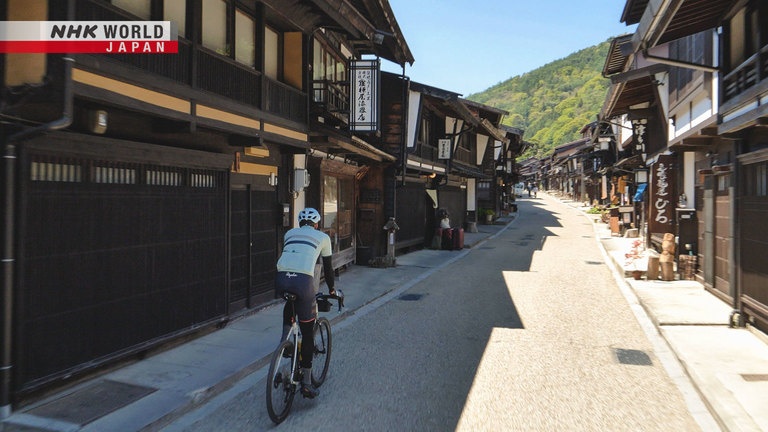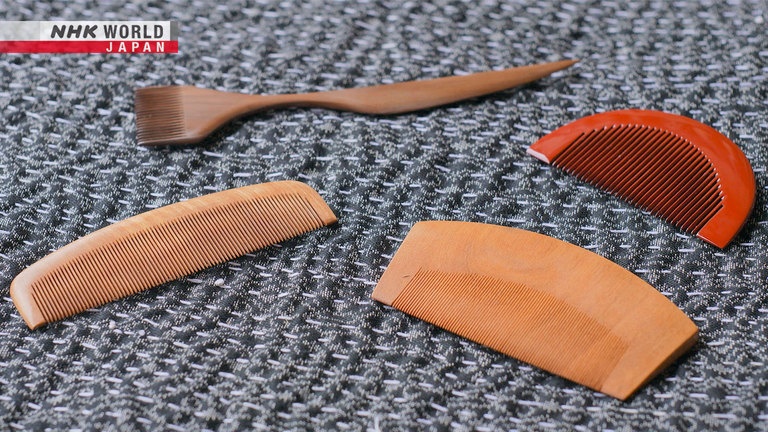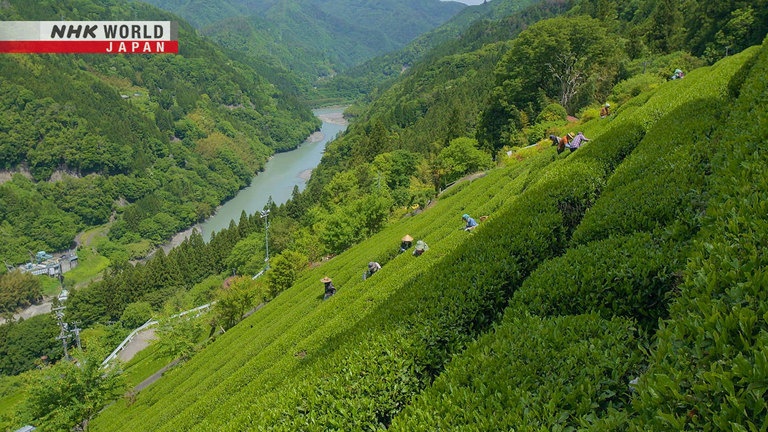Southern Nagano - Exploring Its Hidden Valleys
From Shiojiri, 2.5 hrs by train from Tokyo, we'll ride the 400-year-old Nakasendo highway that linked Edo and Kyoto. After meeting a traditional comb artisan in the post station of Naraijuku, we discover a tradition of crafting rice straw for use in everything from sumo rings to Shinto rituals. At the southern tip of Nagano Prefecture, we scale the steep slopes of a tea plantation.



Transcript
The best way to discover little-known sights and make even familiar places feel brand new,
is to go exploring by bicycle.
This time, we're exploring the southern part of Nagano.
Ooh, woah! That blue!
We'll meet people preserving the bounties of the land.
It's just wonderful to feel that I'm needed.
To become good you just have
to keep taking one step after another.
We'll climb mountains, cross valleys, and visit tucked-away villages.
Let's go!
Two and a half hours from Tokyo by express train has brought us to Shiojiri, the starting point for our ride.
Good morning! Welcome to Nagano!
Michael Rice is from Colorado.
An athlete who's competed in international triathlons, Michael's main passion these days is hill climbing.
Okay, ready for an adventure?
Let's go!
Oh, I like the atmosphere here when you get off the main roads.
Wow, look at that!
We're now on the Nakasendo.
For more than 400 years, this was a major highway connecting Edo and Kyoto,
with 69 post stations along its route.
Oh, there goes the train.
Hey there.
Oh! This is cool!
This is Narai-juku, a typical Nakasendo post station.
These wooden buildings were once inns and tea houses, serving travelers on the highway.
Today, although the population has fallen to 700, the town looks much as it did in its heyday.
Let's see what they have in here.
Hello!
Wow, look at this!
- Is everything made from wood?
- That's right.
For centuries, travelers have been buying souvenirs like these, made with local wood.
These are hand-crafted oroku-gushi combs,
made by a local artisan called Shinohara.
I've never seen such a delicately made comb.
Combs come in many varieties, from hair accessories to those for styling and untangling hair.
Oroku-gushi combs are designed for cleaning,
so they have incredibly fine teeth: as many as 90 in a ten centimeter span.
Michael wants to see how these combs are made.
Hello! Are you the comb craftsman?
Yes, that's me.
- I'd love to watch you work, if that's OK.
- Sure, come in!
Oroku-gushi combs are made from 200-year-old alnus pendula tree wood.
This fine-grained wood is said to be hard enough to break an ax.
- Do you work like this every day?
- I do.
- Since when?
- 50 years.
This is fourth-generation artisan Shinohara Takeshi.
I make my own tools, too.
He uses 10 types of saws, all handmade.
A comb artisan isn't considered qualified until they can make their own tools.
It takes 5 or 6 years to make a saw
that cuts the way I want.
As well as constantly making them sharper,
I keep redesigning them for a better cut.
A special feature of this one is
its smaller second blade.
I'll show you why I added this.
See how it marks a line for the next cut,
so they are always exactly aligned.
This is amazing.
Fifty years ago, when Shinohara began, inexpensive plastic combs were coming into vogue,
and demand for Oroku-gushi combs was sinking.
This didn't deter Shinohara from continuing his craft,
refining his techniques and improving the quality of his combs.
It's like climbing a mountain. Rush at it, and you
run out of breath and never reach the top.
To become good you just have to keep taking
one step after another.
Recently, Oroku-gushi combs have made an unexpected return to popularity.
I'm getting a lot of orders from overseas now.
I just sent a package of 50 to England.
They want the quality that comes from tradition.
It's a real trend.
People are turning away from plastic
and appreciating the feel of wood again.
We're following the Nakasendo as it runs beside the Kiso River.
That's a cool bridge.
Beautiful river.
Michael has left the Kiso River to follow one of its tributaries, the Adera.
These clear blue waters have been christened "Adera blue."
Ooh, woah! That blue! Oh.
I can't believe this color. It's...
It doesn't look like a real color.
The color of this river is so clear, so clean, so pure.
Oh, it's really beyond words.
We leave the mountains and enter the Ina Basin.
You can look down on all the rice fields there.
Wow, this feels nice.
Although the complex terrain in southern Nagano made irrigation difficult at first,
rice is now widely cultivated in this area.
The mountain reflected in the rice fields.
A unique craft developed here as a by-product of rice cultivation.
Here's the place.
I was wanting to meet him.
- Hello!
- Hello! Come in!
- I'm Michael. Are you Sakai san?
- Yes. Pleased to meet you.
Sakai Yuji is a craftsman who works with rice straw.
These are rice bales.
And these are zori straw sandals.
Travelers wore them in the old days.
- Reminds me of samurai movies.
- This was regular footwear back then.
Sakai is one of the very few artisans still working in straw like this.
He is in great demand for specialized traditional items such as those used to make sumo rings.
Sumo was originally a ritual dedicated to the gods,
and rice straw is an important element in the construction of the ring.
Sakai shows Michael the special straw reserved for ritual use.
This is green straw.
It might seem wasteful to cut it before the rice ripens.
But in one sense, it's the most valuable part of
the harvest since it's dedicated to the gods.
Ripe stalks are easily blown over into the dirt,
but green stalks stand firm in the wind.
So green straw symbolizes the invincible
strength of the sumo wrestler.
These are "shimenawa," ropes made of rice straw.
Such sacred ropes are used to mark the boundary between this world and the realm of the gods.
Sakai has made shimenawa for 70 shrines, both inside and outside Nagano.
Sakai belonged to a town revitalization organization.
They planned a marathon in which runners would carry rice bales.
Because there were no longer any local farmers who could make the bales,
Sakai apprenticed with an artisan to learn to make them himself.
Entranced by the depth of the craft, he decided to quit his job and become a straw artisan.
Straw crafts are an incredibly ancient tradition
going back to mythological times.
If I don't keep doing this work,
a whole tradition could just die out.
That would be a terrible loss for our culture.
He now holds classes to help more people learn about this tradition and its appeal.
His dream is to eventually train 2,000 new artisans.
One of his students is Michael King, from the UK.
He moved to Nagano three years ago and became entranced by straw craftwork.
What kind of teacher is he for you?
He's great. He's great.
He's a very interesting man, a bit of a wild man.
He's the kind of person that...
He'll have an idea and everyone will be telling him, "That's a ridiculous idea,"
"That's a crazy idea", "That'll never work," "You'll never...," you know.
So, I've got a lot of respect for him.
What kind of student is he?
Very enthusiastic. My most skilled student
from overseas, a real specialist.
I hope he'll go on to play a big role
in introducing this craft to the world.
The following day, Michael begins in a valley shrouded in morning mist rising from the river.
It feels so nice to be riding through the clouds.
Beautiful mountains.
And the village down below in the valley.
This is awesome.
Oh, look at those tea fields.
What Michael has spotted is a hillside entirely covered in tea plants.
Nothing arouses the passion of our hill climbing enthusiast like an incline going straight up for 365 meters.
That's steep.
Okay, I'm going to go higher.
Hello! Can I come up?
- Sure.
- I want to see this up close.
What a view!
Are all your fields as steep as this?
Yes. The incline here is about 25 degrees.
- How is the tea in this area?
- It's excellent. Very sweet and fragrant.
Nakaisamurai, at the southern edge of Nagano, is full of tea plantations.
The combination of good sunlight and frequent mists from the river make this area ideal for growing tea.
Hello!
- It must be hard working on this slope.
- It's dangerous until you get used to it.
Despite her youth, Maeda Misa manages many of the tea plantations in this valley.
Michael decides to lend a hand with the picking.
Just snap the leaves off at the stem like this.
If you didn't know this was tea,
you'd think it was leaves for making salad.
I was surprised when I first came here.
I'd never seen tea plants before.
Originally an office worker, Maeda moved here five years ago to take up work in the tea fields.
People who live in the mountains
seem to have a special zest for life.
I moved here because I wanted to experience
that myself. No deeper reasons, really.
So you casually moved to one of
the harder places to live?
Yes, I was just curious, I guess.
The average age of farmers here is over 70, and as they approached retirement,
they worried about the future of these tea fields.
They welcomed Maeda, and started entrusting her with the management of their plantations.
Time for a break.
Entire families and their friends gather to help with the tea harvest in May,
so the atmosphere today is lively.
Try this.
It's so good!
Even after we get too old to work ourselves,
we want to keep this tea plantation going.
We're lucky so many people enjoy helping us.
We all have to die someday, but until then
we'll be out working in the fields.
And after that, Misa will keep things going.
I'll try.
What's the biggest difference between
working on a computer and your life here?
It's just wonderful to feel that I'm needed.
I used to wonder what was the purpose of
my work, what was the point of my life.
But working in the tea fields, I never worry about
such things any more. I feel alive and accepted.
Even if the tea plantations continue to shrink,
I'm sure we'll keep on enjoying this life.
There's something special about tea.
The joys of growing tea, a plant that quietly provides so much happiness.
Michael is now on the last leg of his journey.
A good climb.
Wow. This is like a wall.
Wow! What a climb.
From the commanding heights of the Gokuraku Pass,
Michael looks back over the Ina Basin and the surrounding Japan Alps.
He's come to the end of his trip.
What a trip. What a trip. You know.
The people here in the south part of Nagano, I found that they're just doing the simple things in life.
You know, just, they just want a simple, happy, relaxed life.
The people who I met working here and the artisans, they weren't trying to show off.
They weren't trying to make something spectacular to show at a museum.
They are just doing the simple things they need to do to live
but they're doing it in the greatest way possible, you know.
You just need to know what you want to do with your life and then do the best you possibly can.
It's really taught me a lot; being here in Nagano.
Far above the world, in these hidden valleys,
people still understand that true happiness is found in the simple things of life.